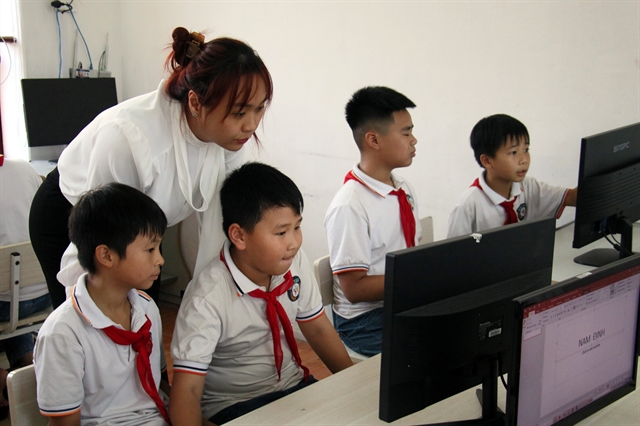 Society
Society

 |
| A session on computer science of students at the Liễu Đề Primary School in the northern province of Ninh Bình. — VNA/VNS Photo Nguyễn Lành |
HÀ NỘI — Việt Nam is drawing up an ambitious plan to bring artificial intelligence (AI) into primary schools, aiming to prepare future generations with the skills of global citizens while ensuring child safety and teacher readiness.
Hồ Đức Thắng, director of the National Institute of Digital Technology and Digital Transformation under the Ministry of Science and Technology, said AI integration in primary education requires a clear and practical five-step action plan. It will be guided by the Prime Minister’s directives, international experience and the particular needs of Việt Nam’s education sector.
The first step is setting achievable and focused goals. The aim is not to produce 'young AI engineers,' but to equip children with three core competencies of global citizens: understanding what AI is, knowing how to use it safely and responsibly, and developing creative thinking when interacting with technology.
To achieve this, Thắng proposed introducing about 5–10 hours of AI-related learning per year from grade 1, embedded into existing subjects and experiential activities, similar to Singapore’s programme launched this year.
The second step is building two mandatory 'safety barriers' to protect children, as education is a sensitive sector requiring strict safeguards. These involve supervision and age restrictions. All activities would take place through school accounts under teachers’ direct guidance. Only AI tools verified by competent authorities for content, student data protection and age suitability could be used.
The third priority is training teachers, regarded as the key to success. Technology cannot replace educators, so the urgent task is to establish a standardised training programme and build a core team of around 1,000 'nuclear' AI teachers to lead and share expertise nationwide, following Estonia’s example.
Fourthly, Việt Nam will draw lessons from abroad while adapting them to its own context.
“We do not copy mechanically, but distil valuable lessons. From Singapore, we learn how to follow short, practical modules, focusing on safety and responsibility. From Estonia, we learn how to prioritise teacher training to be one step ahead. From Korea, we learn not to rush to replace textbooks with applications,” said Thắng.
“Most importantly, from the US, we learn that success comes not only from the curriculum, but from the e-rate programme with a budget of about US$4.9 billion per year to ensure that every school, whether in rural or urban areas, has good Internet.”
The fifth step is to begin with a pilot roadmap lasting 18-24 months.
“Instead of nationwide rollout, we will proceed step by step with solid foundations. Thorough preparation of learning materials and teacher training, followed by piloting in selected localities, then scaling nationwide based on practical results,” Thắng explained.
In summary, integrating AI into primary education is considered timely, but it must be done carefully, with a focus on teachers, safe tools and steady progress.
Law on AI
Alongside plans for popularising AI in schools, the creation of a legal framework for managing its use is also attracting public attention.
AI is regarded as a powerful tool that can generate benefits but also pose risks. The proposed Law on AI therefore focuses not only on cybersecurity but also on ethical concerns, bias and the potential for misuse. A three-layer defence strategy has been suggested.
The first layer is a 'risk filter.' Rather than a blanket ban or approval, the law would classify AI systems by risk level, similar to traffic regulations that differ for bicycles, motorcycles and heavy trucks. Low-risk AI would be given maximum space for creativity, while high-risk AI – systems affecting health, finances or human rights – would be subject to strict controls.
The second layer requires safety from the design stage. High-risk AI systems must undergo rigorous evaluation of data, algorithms and protective measures before reaching the market. Safety is seen as a foundation, not an afterthought.
The third layer is continuous monitoring backed by strong sanctions. Competent authorities would maintain oversight and demand accountability when necessary. Heavy penalties for violations are planned to deter abuse and prevent malicious use of AI.
Thắng said Việt Nam’s approach was to give developers a powerful toolkit alongside a clear and safe user manual – encouraging innovation while ensuring responsibility. — VNS